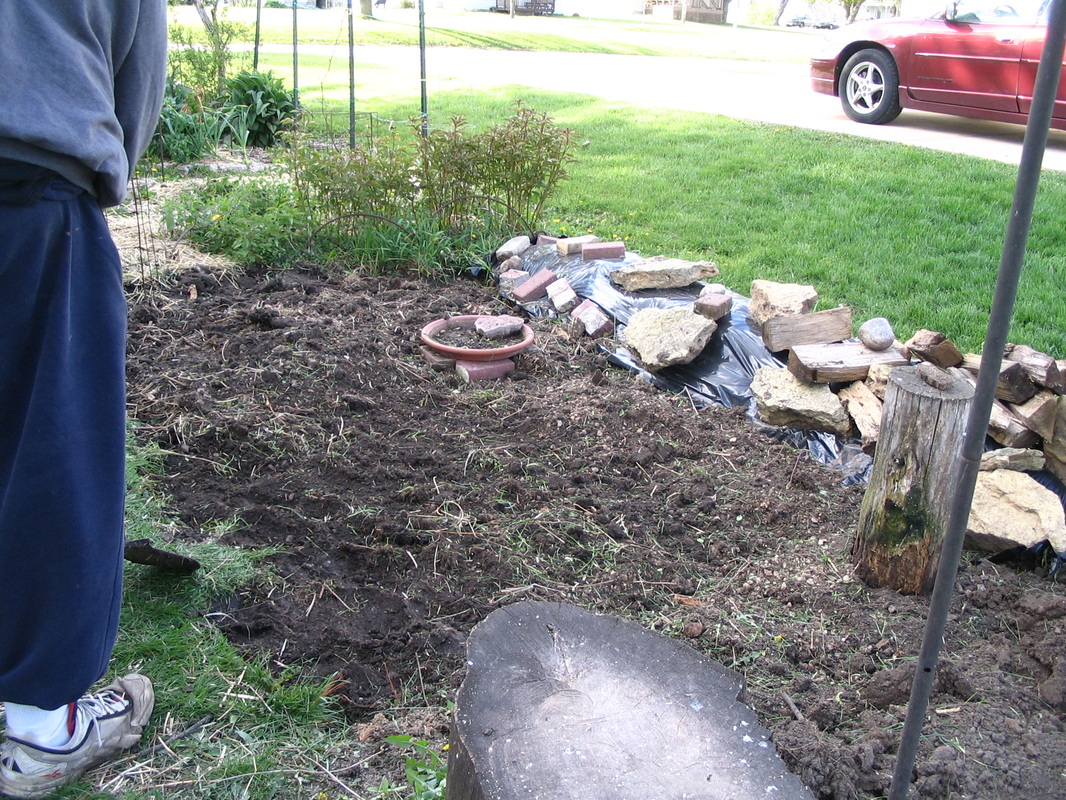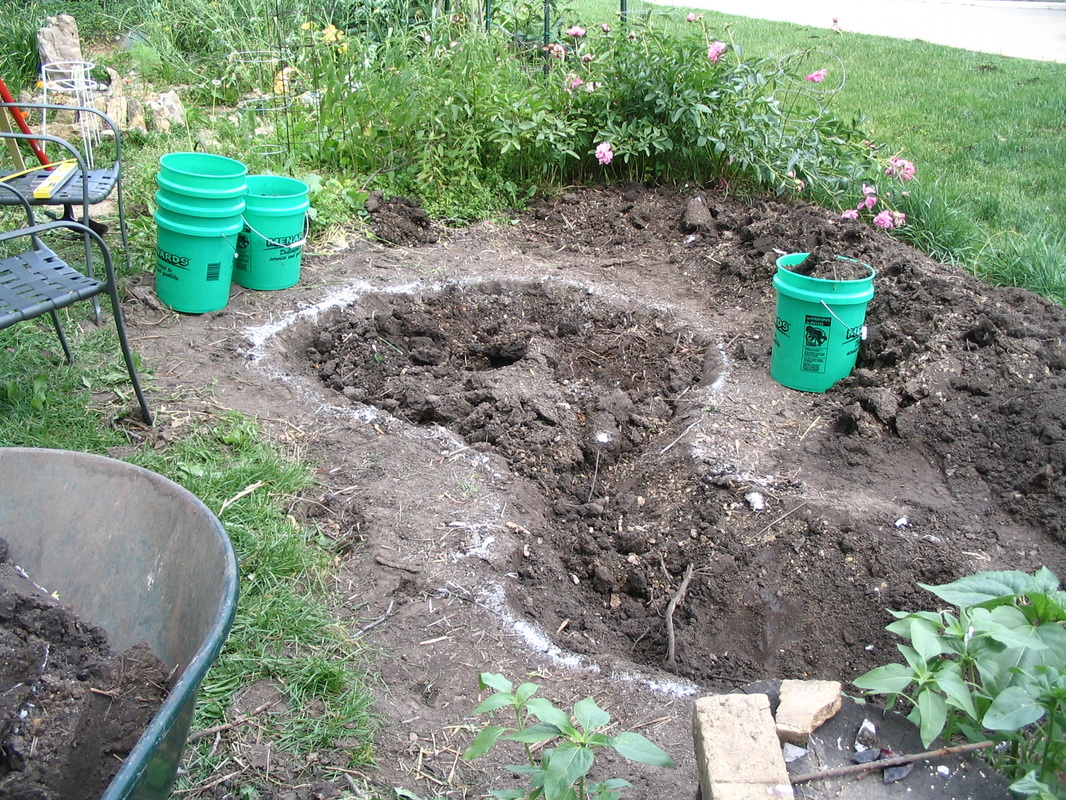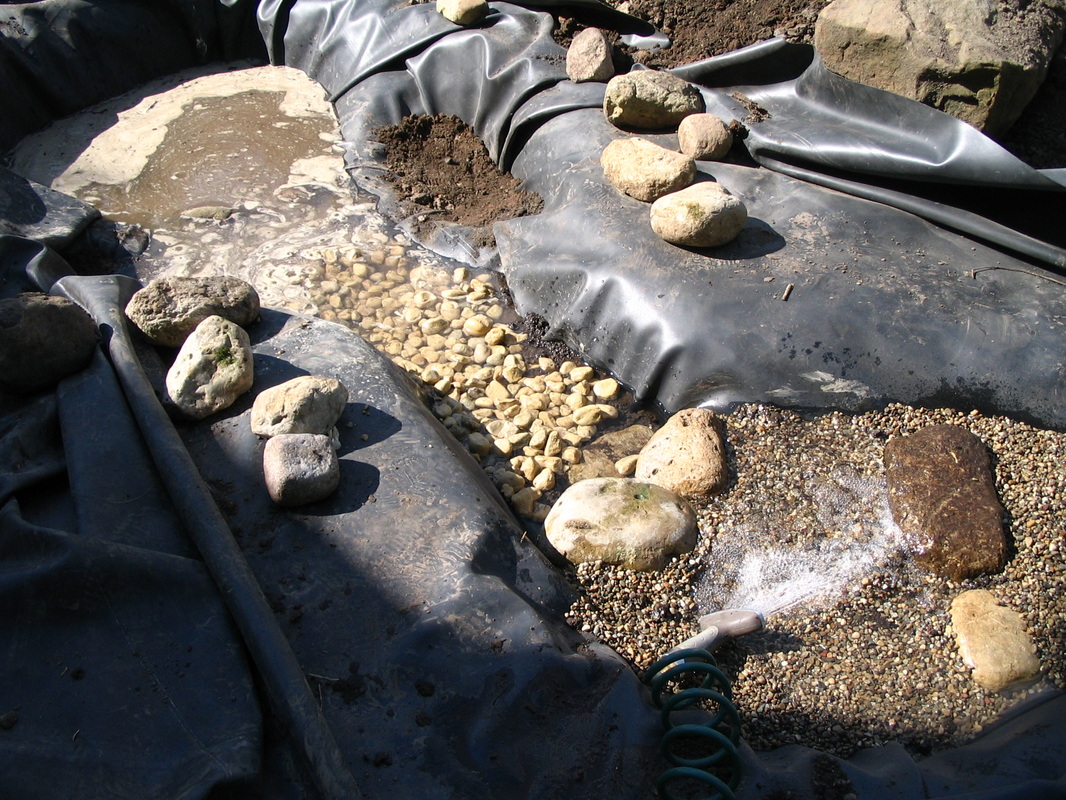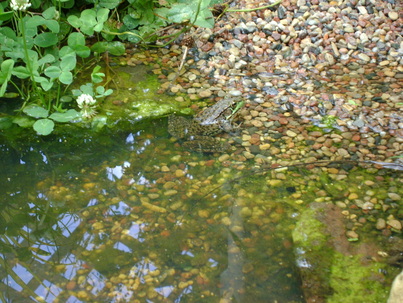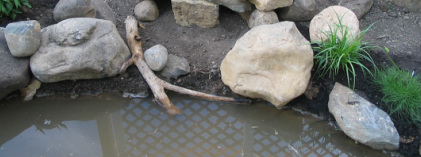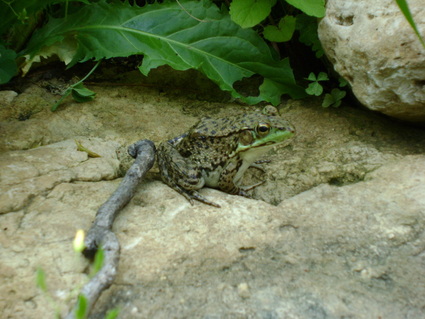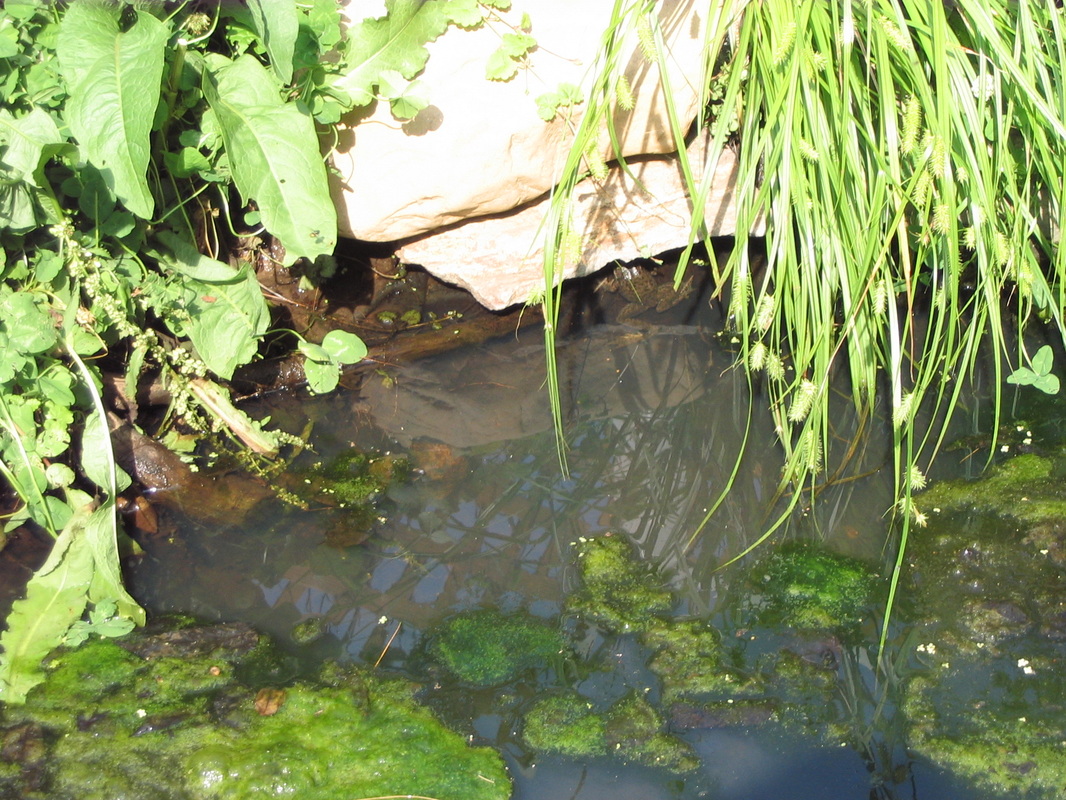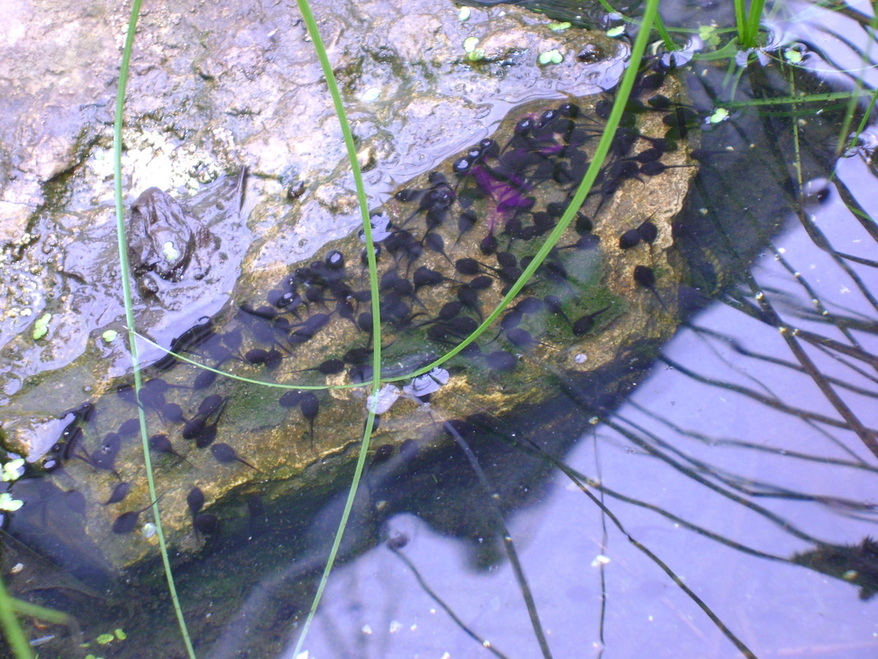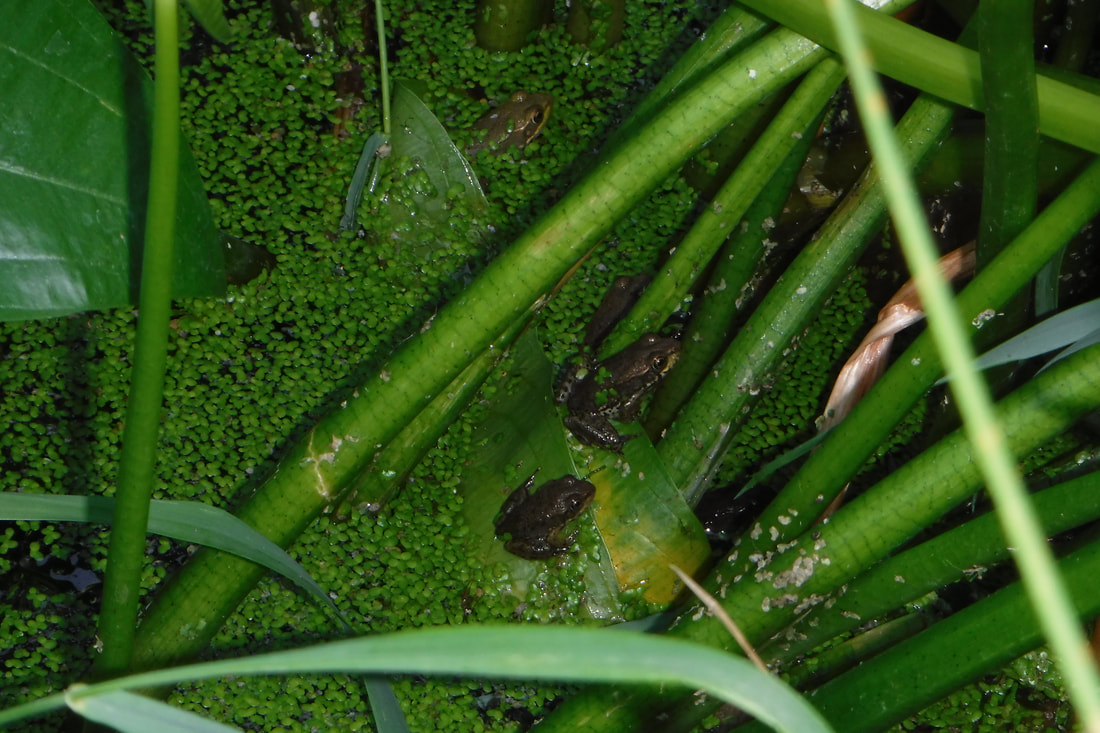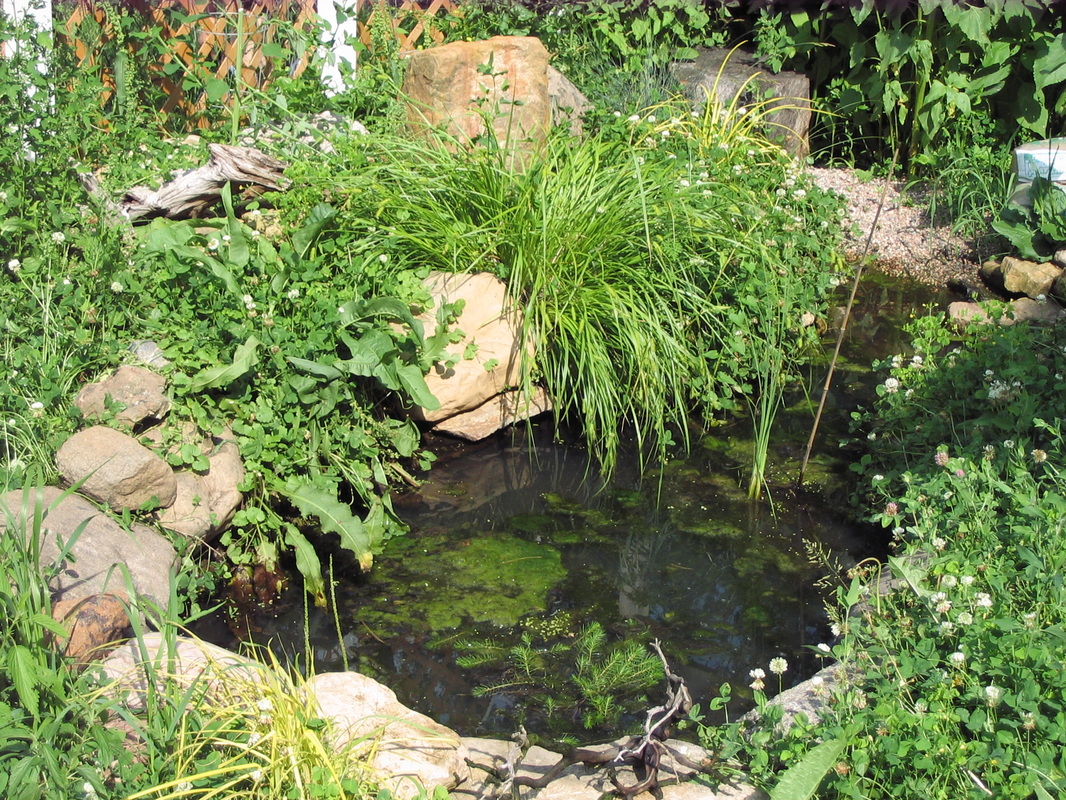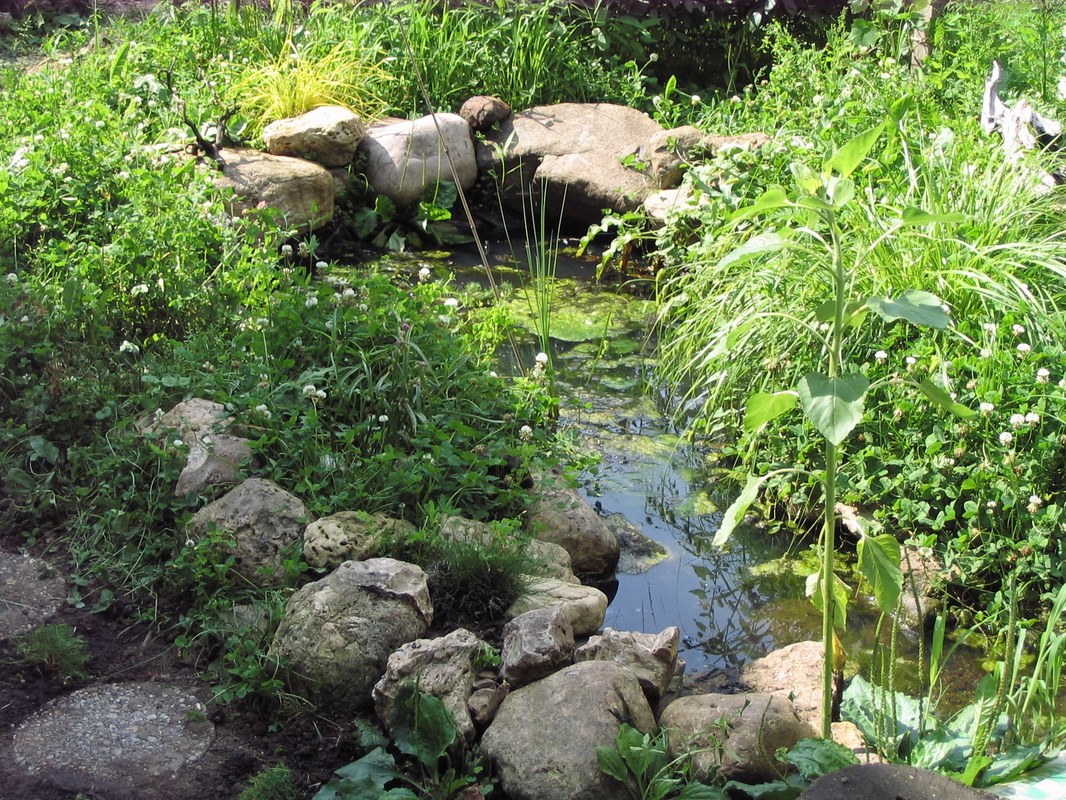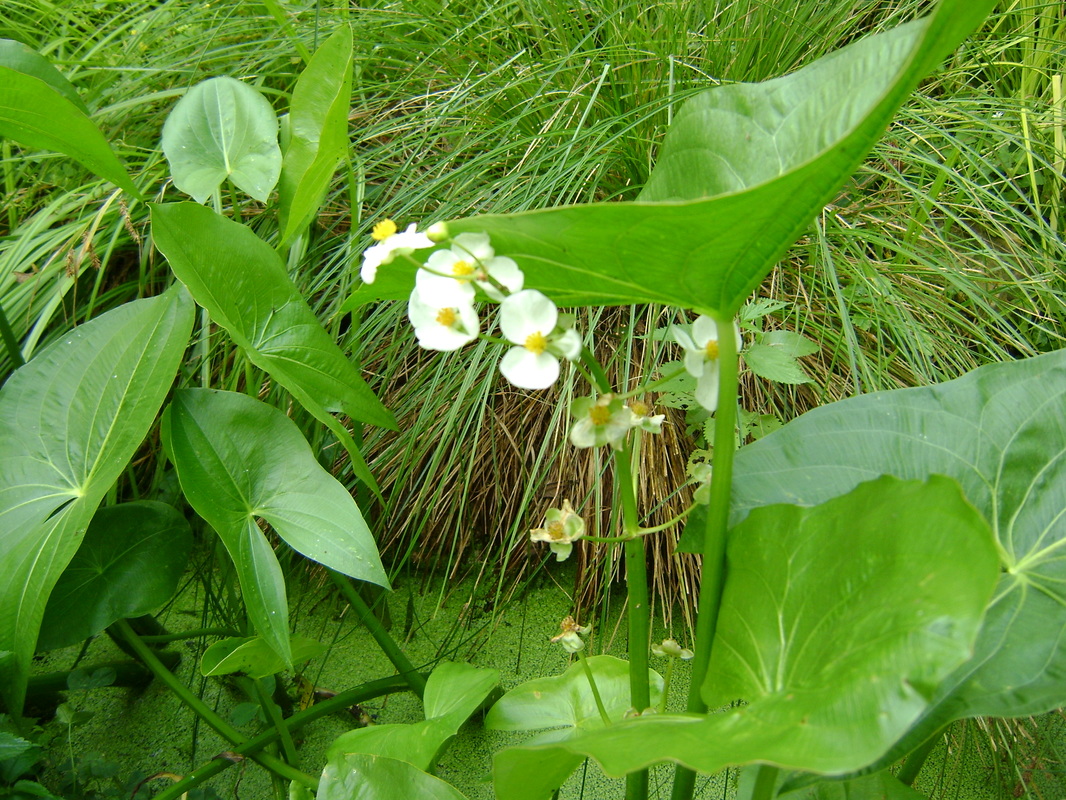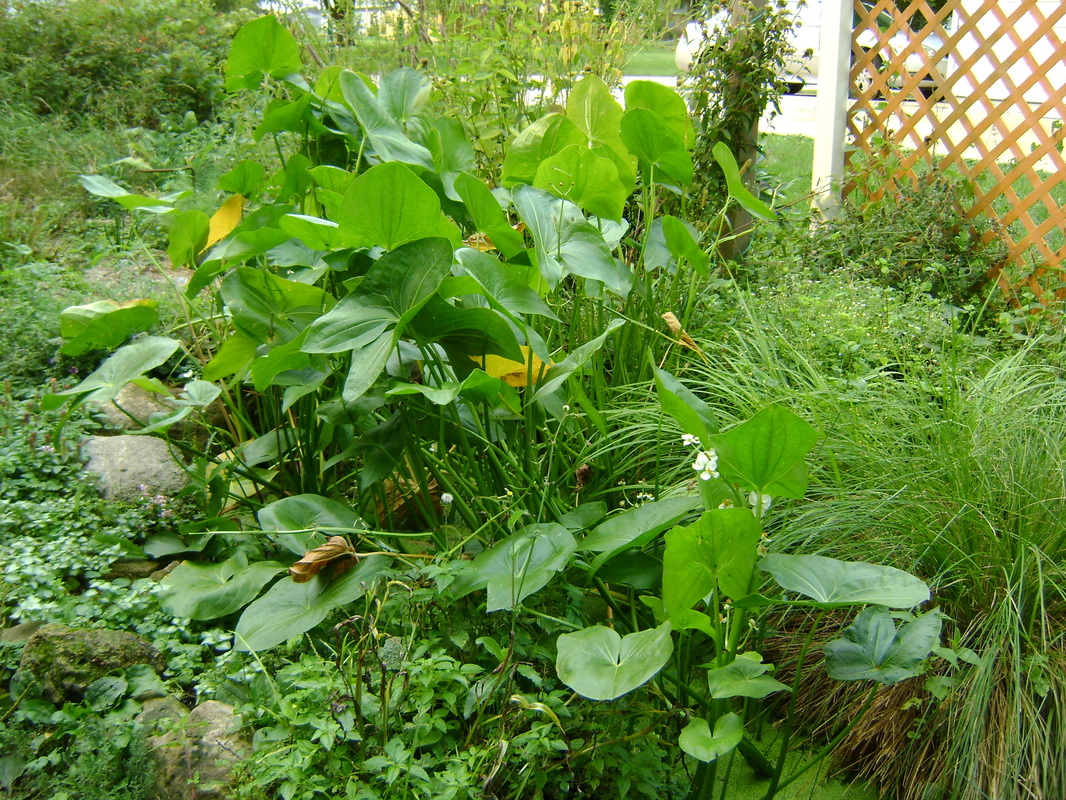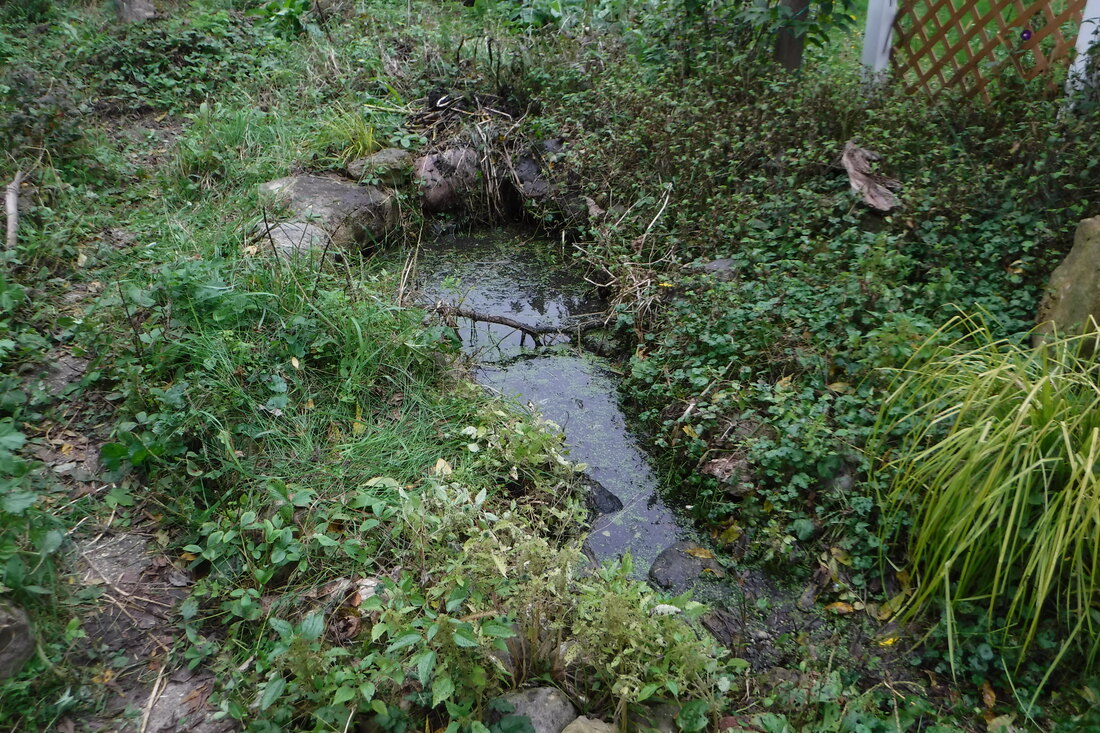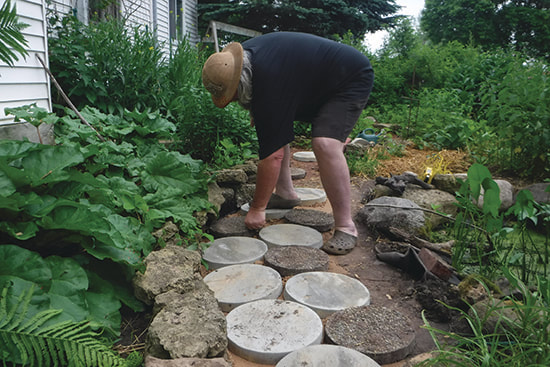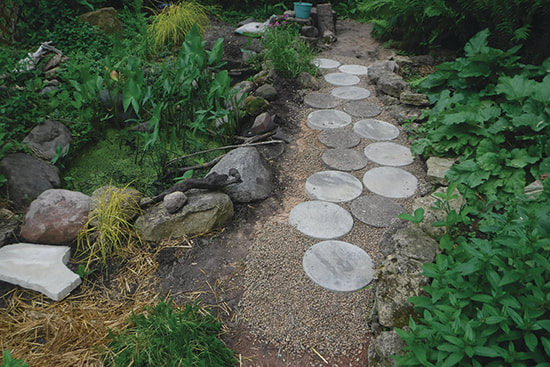BUILDING A BACKYARD WILDLIFE POND
From Theresa
Contents:
- an introduction to our wildlife pond
- our book has complete instructions on how to build your own pond
- a photo preview showing some pond building steps covered in the book
- wildlife seen at our pond
- photos of the pond in later years
Our Wildlife Pond
So far, building a pond has been my favorite and most rewarding garden project. It's one of the best things we've done to create habitat in our tiny yard, as water is the one essential habitat element that benefits all wildlife. For us humans, the pond is fascinating to watch. It is an entrance to another world, one in which humans can't live, even though we are made mostly of water. It is the most mysterious part of our yard, so I am drawn to it more than to any other part of the garden. Having a pond outside our door lets me observe and interact with wildlife I wouldn't otherwise see.
A wildlife pond has some major differences from other types of backyard ponds:
If you're reading about ponds or talking to staff in pond shops, you probably won't find much support for constructing your pond this way. In fact, like me, you might be told that it's impossible to maintain a pond without a pump. However, I did find a few backyard wildlife books that said this is the best way to build a pond, and it has worked well for us since we installed our pond in 2012.
Pond building is not very hard- I did most of the work during a week-long Spring vacation, with some help from Bear. The hardest part was finding information about how to build a pond that would work without a pump, so to make it easier for others I created my own step-by-step instructions, with photos illustrating each step, which I shared on this page for many years. Now, I have published them in an easy to use, revised, and updated book:
A wildlife pond has some major differences from other types of backyard ponds:
- It doesn't have a pump: Pumps can kill small wildlife, such as frog tadpoles, as the pond water is sucked through the pump. The water disturbance that pumps create is also hard on wildlife such as dragonflies, that prefer to breed in still water. Most people think a pond needs a pump so that the water doesn't become stagnant and smelly, and won't breed mosquitoes, however, circulating the water through a pump is not the only way to deal with these issues.
- You put soil in the bottom of the pond: Most ponds constructed by humans have only rocks or gravel at the bottom and the plants are grown in pots. The pots are removed in the Winter and stored indoors, and the plants are repotted into larger pots each Spring. This was way more work than I wanted. Fortunately, in a wildlife pond you add actual dirt to the bottom, in order to create better habitat for animals, and in which you can grow your plants.
- It doesn't have exotic goldfish: Fish will eat frog eggs, and I wanted frogs in our garden because they help keep the garden ecosystem balanced by eating insects, beetles, slugs, and snails.
- It's cheaper: Since we didn't have to buy an expensive pump, our pond cost less than $300, most of which was for a high-quality liner.
- It's easier to maintain: Once I found the right combination of plants, our pond achieved a balanced state that mimicked Nature, and has since required little maintenance from us.
If you're reading about ponds or talking to staff in pond shops, you probably won't find much support for constructing your pond this way. In fact, like me, you might be told that it's impossible to maintain a pond without a pump. However, I did find a few backyard wildlife books that said this is the best way to build a pond, and it has worked well for us since we installed our pond in 2012.
Pond building is not very hard- I did most of the work during a week-long Spring vacation, with some help from Bear. The hardest part was finding information about how to build a pond that would work without a pump, so to make it easier for others I created my own step-by-step instructions, with photos illustrating each step, which I shared on this page for many years. Now, I have published them in an easy to use, revised, and updated book:
I've turned this page of pond building instructions into a book:
Available on Amazon:
Learn more about the book here.
Book Preview/Pond Building Photos:
To give you an idea of what building our pond entailed, here is a preview of some of the photos that illustrate the pond building instructions covered in our book:
Choosing and Preparing Your Location:
Rough Digging the Pond:
Leveling the Edges:
Smoothing the Pond Bottom and Sides:
Installing Newspaper Padding to Protect the Liner:
Installing the Liner:
Filling the Pond with Soil, Rocks, and Water:
Adding Rocks Around the Pond:
The Finished Pond, June 2012:
For instructions describing the above steps, and lots more information on our wildlife pond, see our book:
Wildlife and the Pond
Our pond is a low-maintenance, natural pond specifically intended to be beneficial to wildlife. Bear and I have experienced much joy watching many creatures use and visit it, since water attracts all types of wildlife. I hope you decide to build a similar pond that welcomes frogs, dragonflies, tadpoles, snails, bathing birds, and other creatures where you can have fun observing them in your own yard.
|
Above is a close up of the pebble beach end of our pond. The shallow water and gentle slope lets this frog and other creatures get into and out of the pond. The flat rocks on either side of the water are used by the birds when drinking.
Below you can see one of the logs that I stuck into the deep end of the pond to help creatures access the water. It can also help bugs or small animals get out of the pond if they're stuck. Later I piled more rocks onto the back end of the log to keep it in place.
|
Tips on Building Wildlife Habitat:
To improve the habitat value of your pond, do as much as you can of the following:
|
Wildlife Seen at Our Pond:
Once we finished our pond building at the end of May 2012, wildlife began using it right away:
By July I was amazed that there was a lot more life in the pond water:
By early August I saw a frog! I wasn't expecting them to move in until the following Spring. It was a green frog. The next night I saw it just sitting in the shallow end, probably waiting to catch bugs.
In 2014 we began hearing one peeper frog in the Spring and one or two tree frogs calling during the Summer. These frogs don't live in the pond, but do need to live near water in order to breed. By 2015, we had a much larger chorus of frogs serenading us in the Spring, and we saw tadpoles in the pond for the first time!
- Birds began using it for drinking and bathing immediately. They also took dust baths around the edge before the plants filled in.
- In less than a week there were little beetles living under the water. Where did they come from?
- Non-aggressive mud dabber wasps came to take mud. I don't know where their nests are, but they use mud to build tubes in which they lay their eggs.
- I saw dragonflies laying eggs in the water. They choose still water and hover over it, dipping the end of their tail into the water repeatedly as they lay eggs.
By July I was amazed that there was a lot more life in the pond water:
- There were bigger underwater beetles.
- I found a dozen dragonfly shells stuck to the arrowhead and cattails. The eggs turn into dragonfly nymphs that live underwater, then crawl out of the water to break out of their shells, spread their new wings, and fly away. The information I found said it takes 2-3 years for the nymphs to turn into dragonflies, but it only took a couple months in our pond. (See the photos below.)
- There were dozens of tiny snails.
By early August I saw a frog! I wasn't expecting them to move in until the following Spring. It was a green frog. The next night I saw it just sitting in the shallow end, probably waiting to catch bugs.
In 2014 we began hearing one peeper frog in the Spring and one or two tree frogs calling during the Summer. These frogs don't live in the pond, but do need to live near water in order to breed. By 2015, we had a much larger chorus of frogs serenading us in the Spring, and we saw tadpoles in the pond for the first time!
Here are photos of some of the wildlife that have used our pond:
Dragonflies!
|
Above and right you can see empty dragonfly nymph shells clinging to the miniature cattails and arrowhead. Dragonflies spend the first part of their life cycles underwater, when they're called nymphs. While they're in the pond, they will happily eat any mosquito larvae that show up. When they're ready, they climb up out of the water, breaking out of their shells to spread new wings and fly away as dragonflies.
Dragonfly Rescue
In July of 2014, I was fortunate enough to go outside just after a nymph had emerged from its shell, which is shown on the stem of the arrowhead plant to the right. The shell was still green at this point, but will turn brown later. Unfortunately, the dragonfly that emerged had somehow fallen into the pond water. It was fluttering its wings, but was unable to break away from the surface. I lifted it out with our small rake and was able to enjoy seeing it up close for a few minutes (after running in the house shouting for Bear to come see) before it flew away. |
The Pond in Later Years
Year Two: 2013
Year Three: 2014
|
It's normal to see a lot of algae in the Spring before the plants grow back and help normalize the system.
|
We had an extremely cold Winter in 2013, and the duckweed was the only plant to survive. This year it covered the entire surface of the deep end of the pond. The arrow head (upper left corner) and water hyacinth I added this year.
|
Here's a close up that shows the tiny duckweed covering the surface in between the water hyacinth. Both of these plants float along the surface of the pond, with their roots dangling in the water. Duckweed is supposedly edible, but it's so tiny I'm not sure how it could be collected and cleaned for eating. The "weed" part of its name is what it's considered by most people, but I think it looks good. Before these plants grew, the surface was covered in algae instead.
This year the pond is quite overgrown and bursting with life.
Year Four: 2015
|
This year is looking to be the best yet! As of early June:
|





